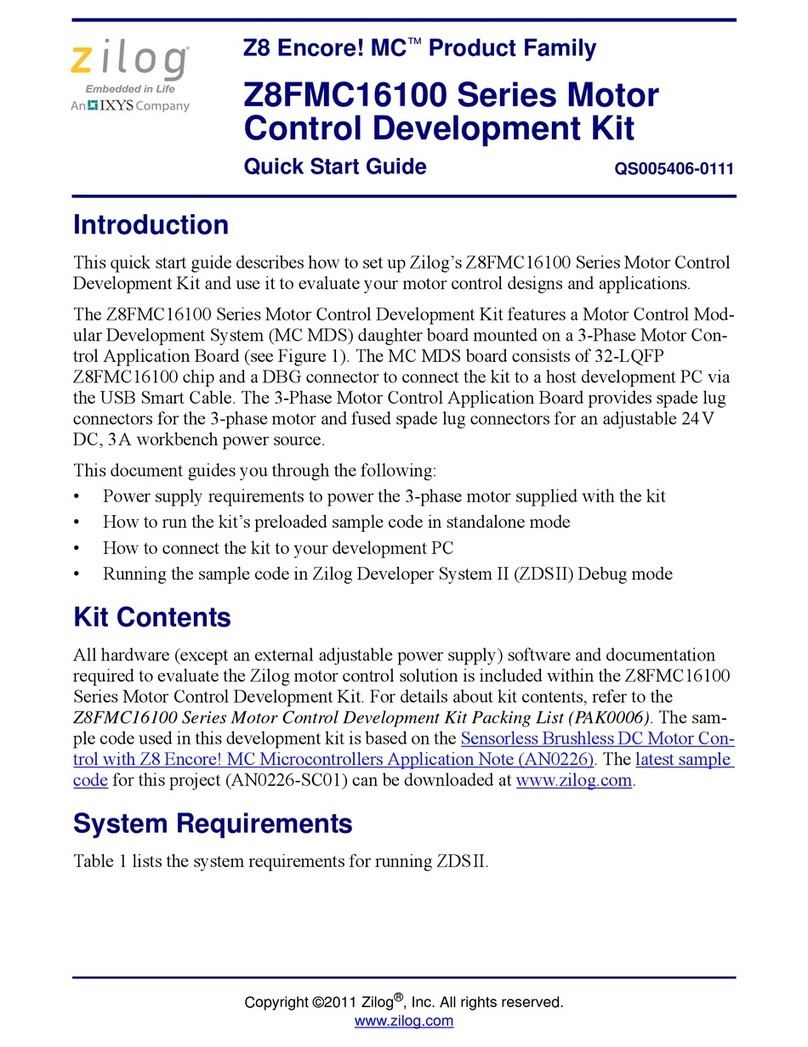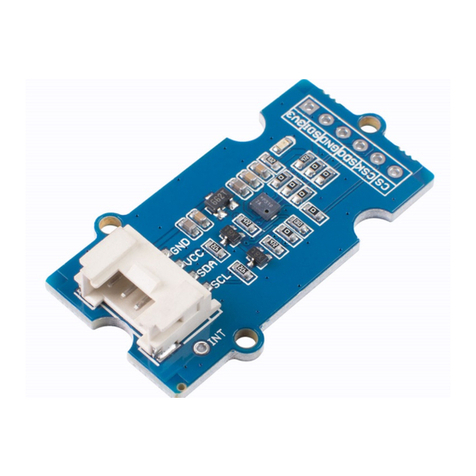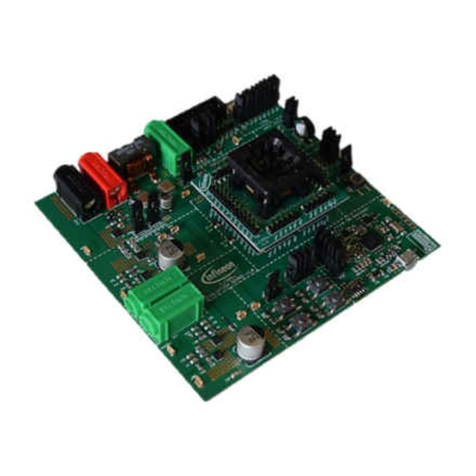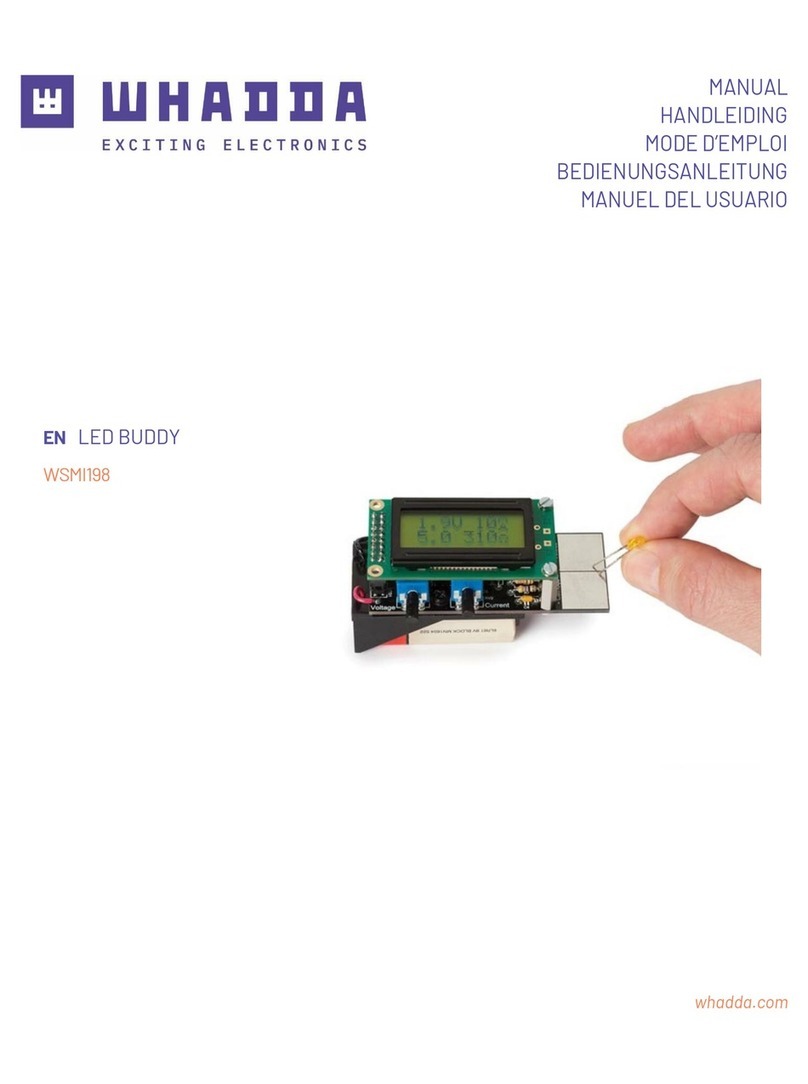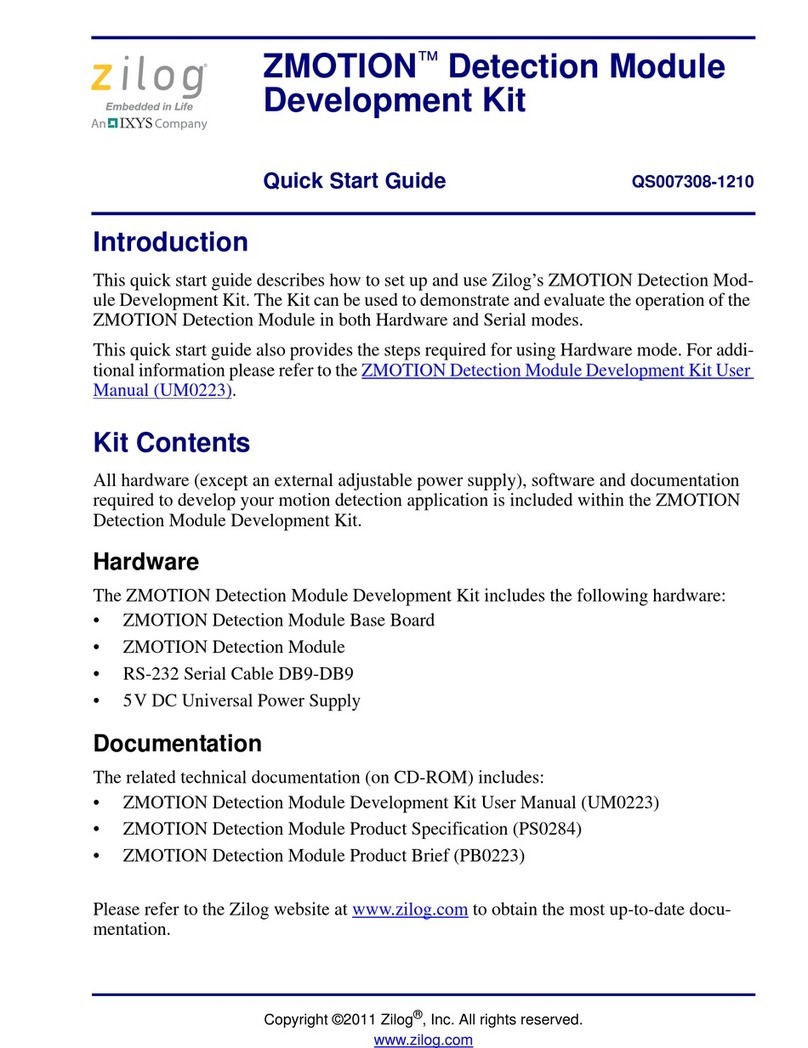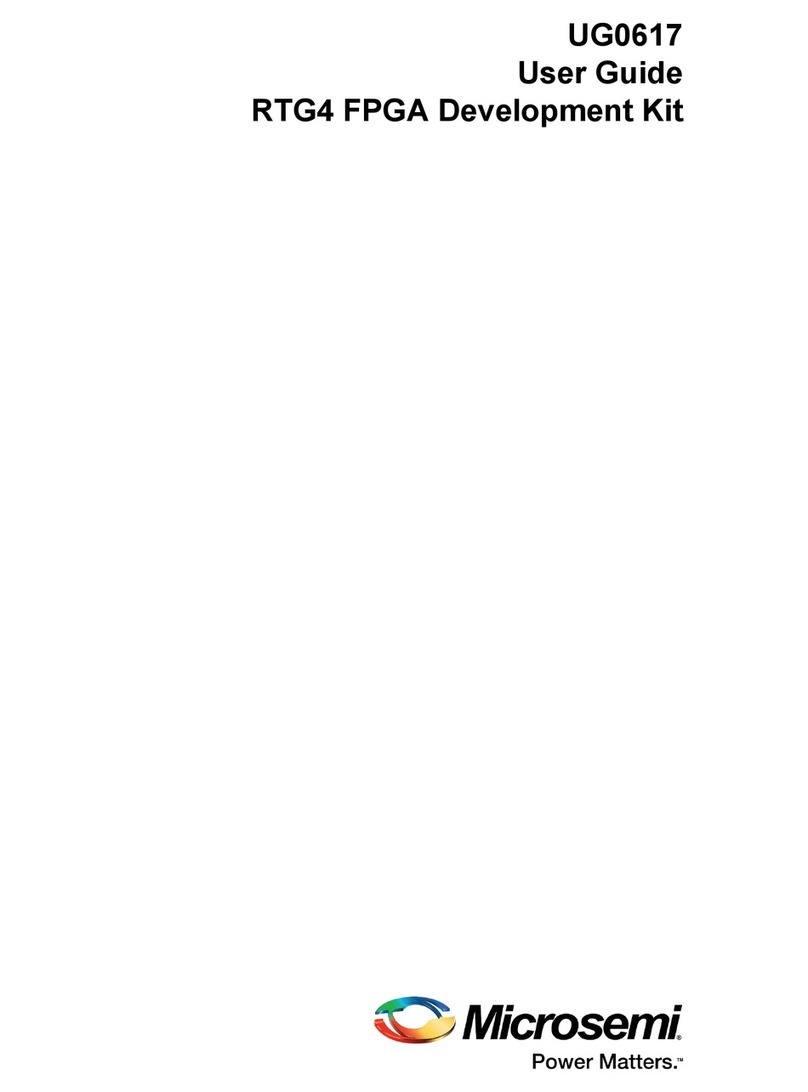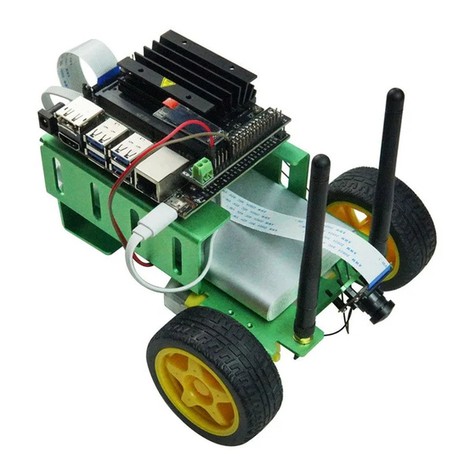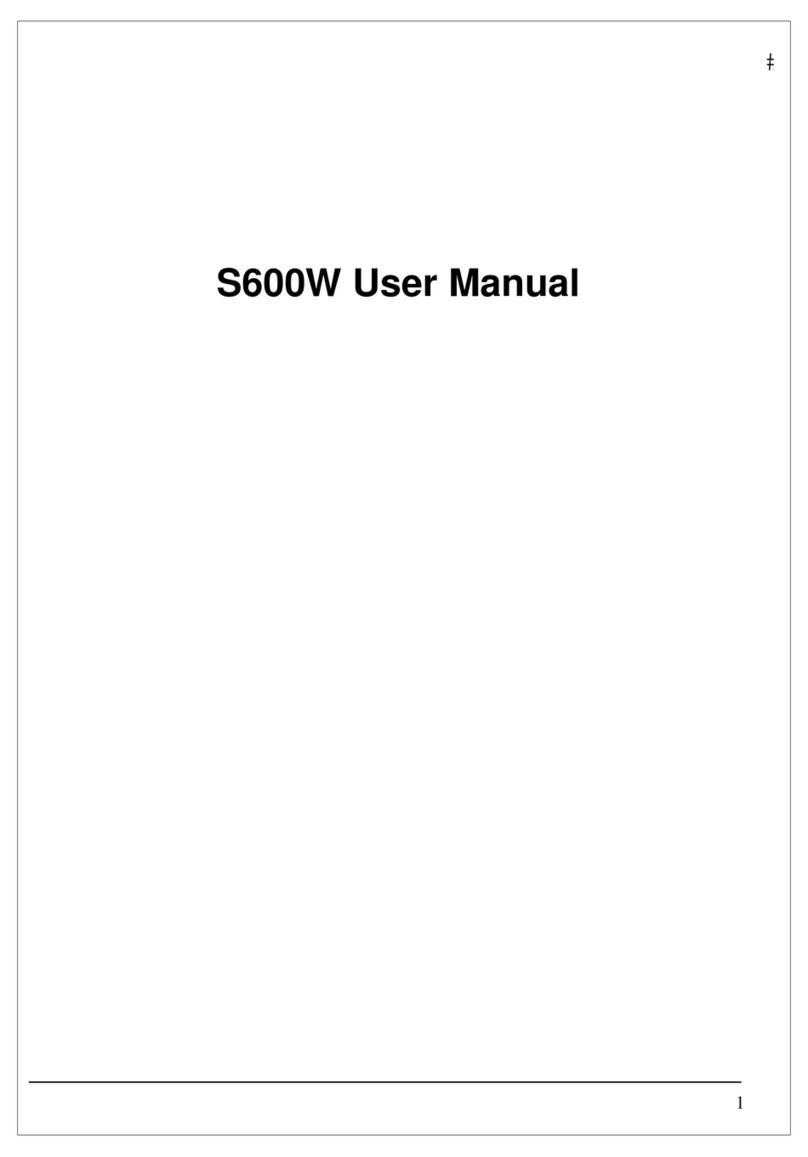TM T81L0006A Series User manual

TE
CH
tm
T81L0006A/B
TM Technology Inc. reserves the right P.1 Publication Date: JAN. 2006
to change products or specifications without notice. Revsion : C
MCU 8-bit A/D Type MCU
1. Features
! Compatible with MCS-51
! Embedded 8K Bytes OTP ROM
! 128 x 8-bit Internal RAM
! 15/19 Programmable I/O Lines for 20/24-pin Package
! Two 16-bit Timer/Counter & One 16-bit Timer
! Two External Interrupt Input (Only One Input for
20-pin Package)
! Two Channel PWM (Only One Channel PWM for
20-pin Package) Driving Capability up to 40 mA
! Embedded 1k bits EEPROM (for T81L0006B only)
! Programmable Serial UART Interface
! Low Power Idle & Power-down Modes
! Watch-dog Timer
! On-chip Crystal & RC Oscillator (Selected by
Bonding Option)
! Internal Power-on Reset and External Reset
Supported
! 8-Channel 8-bit A/D Converter
! SOP20/DIP20 & SOP24/DIP24 Package
! 3.3V Operating Voltage
! EEPORM Interface
!
Low Voltage Reset
2. Applications
•Meter
•Household Appliances Controller
•Handwriting Board
•Charger
•Sport Devices
•Other Controller (Automotive, Toy…)
3. General Description
The T81L0006A/B is 8-bit microcontroller designed and
developed with low power and high speed CMOS
technology. It contains a 8K bytes OTP ROM, a 128 × 8
RAM, an 8-channels 8-bit A/D converter, 15/19 I/O lines, a
watchdog timer, two 16-bit counter/timers, a seven source,
two-priority level nested interrupt structure, two channel
pulsed-width modulator (PWM), a full duplex UART, and
an on-chip oscillator and clock circuits.
In addition, the T81L0006A/B has two selectable modes
of power reduction-idle mode and power-down mode. The
idle mode freezes the CPU while allowing the RAM, timers,
serial port, and interrupt system to continue functioning.
The power-down mode saves the RAM contents but freezes
the oscillator, causing all other chip functions to be
inoperative.
4. Order information
Part number Oscillator
type EEPROM Package
T81L0006A-AK RC NONE 24-pin DIP
T81L0006A-BK Crystal NONE 24-pin DIP
T81L0006A-CK RC NONE 20-pin DIP
T81L0006A-DK Crystal NONE 20-pin DIP
T81L0006A-AD RC NONE 24-pin SOP
T81L0006A-BD Crystal NONE 24-pin SOP
T81L0006A-CD RC NONE 20-pin SOP
T81L0006A-DD Crystal NONE 20-pin SOP
T81L0006B-AK RC Embedded 24-pin DIP
T81L0006B-BK Crystal Embedded 24-pin DIP
T81L0006B-AD RC Embedded 24-pin SOP
T81L0006B-BD Crystal Embedded 24-pin SOP
Downloaded from Elcodis.com electronic components distributor

TE
CH
tm
T81L0006A/B
TM Technology Inc. reserves the right P.2 Publication Date: JAN. 2006
to change products or specifications without notice. Revsion : C
5. Block Diagram
Port 1 Drivers
RAM Addr.
Register RAM
Port 1
Latch
OTP
ROM
B Register ACC Stack
Pointer
TMP2 TMP1
ALU
PSW
Interrupt, Serial port,
and Timer Block
Timing &
Control Instruction
Register
Port 3
Latch
Port 3 Drivers
Program Address
Register
Buffer
PC
Incrementer
Program
Counter
DPTR
P1.0 -P1.7P3.0 -P3.7
RST
OSC
WDT
PWM
Port 2 Drivers
ADC
Port 2
Latch
P2.0 P2.3P2.1XTAL2XTAL1
EEPROM
interface
EEPROM
Downloaded from Elcodis.com electronic components distributor

TE
CH
tm
T81L0006A/B
TM Technology Inc. reserves the right P.3 Publication Date: JAN. 2006
to change products or specifications without notice. Revsion : C
6. Pin Configuration
(TXD) P3.1
(RXD) P3.0
(ADI0) P1.0
1
2
322
24
23
(T1) P3.5
(T0) P3.4
OSC-R
19
21
20
STOP
RST/VPP
VCC
16
18
17
P2.1
(VREF) P3.7
(PWM2) P2.0
13
15
14
(PWM1) P3.6
(INT0) P3.2
(ADI7) P1.7
(INT1) P3.3
(ADI1) P1.1
GND
4
5
6
(ADI2) P1.2
P2.3
(ADI3) P1.3
7
8
9
(ADI5) P1.5
(ADI4) P1.4
(ADI6) P1.6
10
11
12
DIP-24/SOP-24 For RC Oscillator
T81L0006A-AK/ T81L0006A-AD
T81L0006B-AK/ T81L0006B-AD
(TXD) P3.1
(RXD) P3.0
(ADI0) P1.0
1
2
322
24
23
(T1) P3.5
(T0) P3.4
XIN
19
21
20
XOUT
RST/VPP
VCC
16
18
17
P2.1
(VREF) P3.7
(PWM2) P2.0
13
15
14
(PWM1) P3.6
(INT0) P3.2
(ADI7) P1.7
(INT1) P3.3
(ADI1) P1.1
GND
4
5
6
(ADI2) P1.2
P2.3
(ADI3) P1.3
7
8
9
(ADI5) P1.5
(ADI4) P1.4
(ADI6) P1.6
10
11
12
DIP-24/SOP-24 For Crystal Oscillator
T81L0006A-BK/ T81L0006A-BD
T81L0006B-BK/ T81L0006B-BD
(TXD) P3.1
(RXD) P3.0
(ADI0) P1.0
1
2
3
(T1) P3.5
(T0) P3.4
OSC-R
19
20
STOP
RST/VPP
VCC
16
18
17
(VREF) P3.7
13
15
14
(PWM1) P3.6
(INT0) P3.2
(ADI7) P1.7
(ADI1) P1.1
GND
4
5
6
(ADI2) P1.2
(ADI3) P1.3 7
8
9
(ADI5) P1.5
(ADI4) P1.4
(ADI6) P1.6 10 11
12
DIP-20/SOP-20 For RC Oscillator
T81L0006A-CK/ T81L0006A-CD
(TXD) P3.1
(RXD) P3.0
(ADI0) P1.0
1
2
3
(T1) P3.5
(T0) P3.4
XIN
19
20
XOUT
RST/VPP
VCC
16
18
17
(VREF) P3.7
13
15
14
(PWM1) P3.6
(INT0) P3.2
(ADI7) P1.7
(ADI1) P1.1
GND
4
5
6
(ADI2) P1.2
(ADI3) P1.3 7
8
9
(ADI5) P1.5
(ADI4) P1.4
(ADI6) P1.6 10 11
12
DIP-20/SOP-20 For Crystal Oscillator
T81L0006A-DK/ T81L0006A-DD
Downloaded from Elcodis.com electronic components distributor

TE
CH
tm
T81L0006A/B
TM Technology Inc. reserves the right P.4 Publication Date: JAN. 2006
to change products or specifications without notice. Revsion : C
7. Pin Description
8. Temperature Limit Ratings
Parameter Rating Units
Operating temperature Range -40 to +85 °C
Storage Temperature Range -55 to +125 °C
Number
(24-Pin) Number
(20-Pin) Name Type Description
1 1 P3.0/(RXD) I/O
General-purpose I/O pin (Default) or Serial input port.
2 2 P3.1/(TXD) I/O
General-purpose I/O pin (Default) or Serial output port.
3 3 P1.0/(ADI0) I/O
General-purpose I/O pin (Default) or ADC input channel 0.
4 4 P1.1/(ADI1) I/O
General-purpose I/O pin (Default) or ADC input channel 1.
5 - P3.3/(INT1) I/O
General-purpose I/O pin (Default) or External interrupt source 1.
6 5 GND
Ground
7 - P2.3 I/O
General-purpose I/O pin.
8 6 P1.2/(ADI2) I/O
General-purpose I/O pin (Default) or ADC input channel 2.
9 7 P1.3/(ADI3) I/O
General-purpose I/O pin (Default) or ADC input channel 3.
10 8 P1.4/(ADI4) I/O
General-purpose I/O pin (Default) or ADC input channel 4.
11 9 P1.5/(ADI5) I/O
General-purpose I/O pin (Default) or ADC input channel 5.
12 10 P1.6/(ADI6) I/O
General-purpose I/O pin (Default) or ADC input channel 6.
13 11 P1.7/(ADI7) I/O
General-purpose I/O pin (Default) or ADC input channel 7.
14 12 P3.2/(INT0) I/O
General-purpose I/O pin (Default) or External interrupt source 0.
15 13 P3.6/(PWM1) I/O
General-purpose I/O pin (Default) or PWM signal output channel 1.
16 - P2.0/(PWM2) I/O
General-purpose I/O pin (Default) or PWM signal output channel 2.
17 14 P3.7/(VREF) I/O
General-purpose I/O pin (Default) or External reference voltage input
pin for ADC.
18 - P2.1 I/O
General-purpose I/O pin.
19 15 VCC
3.3V power supply.
20 16 RST/VPP I
Reset signal input or programming supply voltage input.
21 17 XOUT/(STOP) O
Crystal oscillator output terminal or stop RC oscillator network.
22 18 XIN/(OSC-R) I
Crystal oscillator input terminal or RC oscillator external resister
connect pin.
23 19 P3.4/(T0) I/O
General-purpose I/O pin (Default) or Timer 0 external input pin.
24 20 P3.5/(T1) I/O
General-purpose I/O pin (Default) or Timer 1 external input pin.
Downloaded from Elcodis.com electronic components distributor

TE
CH
tm
T81L0006A/B
TM Technology Inc. reserves the right P.5 Publication Date: JAN. 2006
to change products or specifications without notice. Revsion : C
9. Electrical Characteristics
D.C Characteristics
Symbol Parameter Conditions Min Typ Max Units
VCC Operating Voltage 25°C 3.0 3.3 3.6 V
ICC Operating Current No load, ADC disable Vcc=3.3V - 6 - mA
IPD Power-Down Current No load, Vcc=3.3V 1 uA
IADC Only ADC Enable, Others
Disable No load - 120 - uA
VADC ADC Input Voltage Range 0 - VREF V
VREF V
REF input voltage range 2 - VCC V
VIH Hi-Level input voltage Vout >=VVOH(MIN.)
Vout <=VVOL(MIN.) 2.1 - - V
VIL Low-Level input voltage Vout >=VVOH(MIN.)
Vout <=VVOL(MIN.) - - 0.6 V
IOH=-7uA 2.9
IOH=-45uA 2.4
IOH=-70uA 1.9
IOH=-12mA** 2.4
VOH Hi-Level Output voltage VCC=MIN.
VI=VIH or
VIL
IOH=-20mA** 1.9
- - V
IOL=12mA 0.2
IOL=25mA 0.4
VOL1 * Low-Level Output voltage VCC=MIN.
VI=VIH or
VIL IOL=40mA - -
0.6 V
IOL=4mA 0.2
IOL=12mA 0.4
VOL2 ** Low-Level Output voltage VCC=MIN.
VI=VIH or
VIL IOL=20mA
0.6 V
Note : * for PWM pins (P3.6/PWM1 and P2.0/PWM2).
** for high driving current mode.
A.C Characteristics
Symbol Parameter Conditions Min Typ Max Units
FSYS1 System Clock 1 (Crystal OSC) VCC=3.3V - 12 24 MHz
FSYS2 System Clock 2 (RC OSC) VCC=3.3V - 12 - MHz
FADC ADC Clock Frequency - 125 - KHz
tACT ADC Conversion Time - 128 us
tRES External Reset High Pulse Width - 10 - system cycle
tPOS Power ON Start up Time - 20 - ms
tLHLL ALE pulse width 127 - - ns
tAVLL Address Valid to ALE Low 43 - - ns
tLLAX Address Hold after ALE Low 48 - - ns
tLLIV ALE Low to Valid Instruction In - - 233 ns
tLLPL ALE Low to PSEN Low 43 - - ns
tPLPH PSEN pulse width 205 - - ns
tPLIV PSEN Low to Valid Instruction In - - 145 ns
tAVIV Address to Valid Instruction In - - 312 ns
tRLRH RD pulse width 400 - - ns
tWLWH WR pulse width 400 - ns
tRLDV RD Low to Valid data in - - 252 ns
tLLDV ALE Low to Valid data in - - 517 ns
tAVDV Address to Valid data in - - 585 ns
tLLWL ALE Low to RD or WR Low 200 - 300 ns
tAVWL Address to RD or WR Low 203 - - ns
tWHLH RD or WR High to ALE High 43 - 123 ns
Downloaded from Elcodis.com electronic components distributor

TE
CH
tm
T81L0006A/B
TM Technology Inc. reserves the right P.6 Publication Date: JAN. 2006
to change products or specifications without notice. Revsion : C
10. Function Description
10.1 Reset
For Power on Reset only For Power on Reset and External Reset
10.2 Oscillation
RC Oscillator Crystal Oscillator
T81L0006A/B
1
2
3
4
5
6
7
8
9
10
11
12 13
14
15
16
17
18
19
20
21
22
23
24
P30
P31
P10
P11
P33
VSS
P23
P12
P13
P14
P15
P16 P17
P32
P36
P20
P37
P21
VCC
RST
XOUT
XIN
P34
P35
VCC
T81L0006A/B
1
2
3
4
5
6
7
8
9
10
11
12 13
14
15
16
17
18
19
20
21
22
23
24
P30
P31
P10
P11
P33
VSS
P23
P12
P13
P14
P15
P16 P17
P32
P36
P20
P37
P21
VCC
RST
XOUT
XIN
P34
P35
8.2K
51K
T81L0006A/B-A
1
2
3
4
5
6
7
8
9
10
11
12 13
14
15
16
17
18
19
20
21
22
23
24
P30
P31
P10
P11
P33
VSS
P23
P12
P13
P14
P15
P16 P17
P32
P36
P20
P37
P21
VCC
RST
STOP
OSCR
P34
P35
T81L0006A/B-B
1
2
3
4
5
6
7
8
9
10
11
12 13
14
15
16
17
18
19
20
21
22
23
24
P30
P31
P10
P11
P33
VSS
P23
P12
P13
P14
P15
P16 P17
P32
P36
P20
P37
P21
VCC
RST
XOUT
XIN
P34
P35 22p
2.2M
Y1
22p
Downloaded from Elcodis.com electronic components distributor

TE
CH
tm
T81L0006A/B
TM Technology Inc. reserves the right P.7 Publication Date: JAN. 2006
to change products or specifications without notice. Revsion : C
10.3 Special Function Register
F8H
F0HB
E8H
E0HACC
D8H
D0HPSW
C8H T2CON T2MOD RCAP2L RCAP2H TL2 TH2
C0H
B8HIP
B0HP3
A8HIE
A0HP2
98H SCON SBUF
90HP1
88H TCON TMOD TL0 TL1 TH0 TH1
80H P0* SP DPL DPH WDREL PCON
*Note: P0:Internal still keeping, but for pad dominate, no external pin assignment
Accumulator : ACC
ACC is the Accumulator register. The mnemonics for Accumulator-Specific instructions, however, refer to the
Accumulator simply as A.
B Register : B
The B register is used during multiply and divide operations. For other instructions it can be treated as another scratch
pad register.
Program Status Word : PSW
The PSW register contains program status information as detailed in
CY AC F0 RS1 RS0 OV -- P
BIT SYMBOL FUNCTION
PSW.7 CY Carry flag.
PSW.6 AC Auxiliary Carry flag. (For BCD operations.)
PSW.5 F0 Flag 0. (Available to the user for general purposes.)
PSW.4 RS1 Register bank select control bit 1.
Set/cleared by software to determine working register bank. (See Note.)
PSW.3 RS0 Register bank select control bit 0.
Set/cleared by software to determine working register bank. (See Note.)
PSW.2 OV Overflow flag.
PSW.1 — User-definable flag.
PSW.0 P Parity flag.
Set/cleared by hardware each instruction cycle to indicate an odd/even number of “one” bits in the
Accumulator, i.e., even parity.
NOTE: The contents of (RS1, RS0) enable the working register banks as follows:
(0,0)— Bank 0 (00H–07H)
(0,1)— Bank 1 (08H–0fH)
(1,0)— Bank 2 (10H–17H)
(1,1)— Bank 3 (18H–17H)
Downloaded from Elcodis.com electronic components distributor

TE
CH
tm
T81L0006A/B
TM Technology Inc. reserves the right P.8 Publication Date: JAN. 2006
to change products or specifications without notice. Revsion : C
Stack Pointer : SP
The Stack Pointer register is 8 bits wide. It is incremented before data is stored during PUSH and CALL executions.
While the stack may reside anywhere in on-chip RAM, the Stack Pointer is initialized to 07H after a reset. This causes the
stack to begin at locations 08H.
Data Pointer (DPTR) : DPH & DPL
The Data Pointer (DPTR) consists of a high byte (DPH) and a low byte (DPL). Its intended function is to hold a 16-bit
address. It may be manipulated as a 16-bit register or as two independent 8-bit registers.
Ports 1.0~1.7 & 2.0,2.1,2.3 & 3.0~3.7
All Ports are the SFR latches, respectively. Writing a one to a bit of a port SFR (P1 or P2 or P3) causes the
corresponding port output pin to switch high. Writing a zero causes the port output pin to switch low. When used as an input,
the external state of a port pin will be held in the port SFR (i.e., if the external state of a pin is low, the corresponding port
SFR bit will contain a ‘0’; if it is high, the bit will contain a ‘1’).
Serial Data Buffer : SBUF
The Serial Buffer is actually two separate registers, a transmit buffer and a receive buffer. When data is moved to
SBUF, it goes to the transmit buffer and is held for serial transmission. (Moving a byte to SBUF is what initiates the
transmission.) When data is moved from SBUF, it comes from the receive buffer.
Timer Registers : TH0, TL0, TH1, TL1,TH2,TL2
Register pairs (TH0, TL0) and (TH1, TL1) and (TH2, TL2) are 16-bit Counting registers for Timer/Counters 0 and
Timer1and Timer2, respectively.
.
Control Register : IP, IE, TMOD, TCON, SCON, PCON
Special Function Registers IP, IE, TMOD, TCON, SCON, and PCON contain control and status bits for the interrupt
system, the Timer/Counters, and the serial port. They are described in later sections.
Standard Serial Interface
The serial port is full duplex, meaning it can transmit and receive simultaneously. It is also receive-buffered, meaning it
can commence reception of a second byte before a previously received byte has been read from the register. (However, if the
first byte still hasn’t been read by the time reception of the second byte is complete, one of the bytes will be lost.) The serial
port receive and transmit registers are both accessed at Special Function Register SBUF. Writing to SBUF loads the transmit
register, and reading SBUF accesses a physically separate receive register.
The serial port can operate in 4 modes:
Mode 0: Serial data enters and exits through RxD. TxD outputs the shift clock. 8 bits are transmitted/received (LSB first).
The baud rate is fixed at 1/12 the oscillator frequency.
Mode 1: 10 bits are transmitted (through TxD) or received (through RxD): a start bit (0), 8 data bits (LSB first), and a stop
bit (1). On receive, the stop bit goes into RB8 in Special Function Register SCON. The baud rate is variable.
Mode 2: 11 bits are transmitted (through TxD) or received (through RxD): start bit (0), 8 data bits (LSB first), a
programmable 9th data bit, and a stop bit (1). On Transmit, the 9th data bit (TB8 in SCON) can be assigned the value of 0 or
1. Or, for example, the parity bit (P, in the PSW) could be moved into TB8. On receive, the 9th data bit goes into RB8 in
Special Function Register SCON, while the stop bit is ignored. The baud rate is programmable to either 1/32 or 1/64 the
oscillator frequency.
Mode 3: 11 bits are transmitted (through TxD) or received (through RxD): a start bit (0), 8 data bits (LSB first), a
programmable 9th data bit, and a stop bit (1). In fact, Mode 3 is the same as Mode 2 in all respects except baud rate. The
baud rate in Mode 3 is variable. In all four modes, transmission is initiated by any instruction that uses SBUF as a destination
register. Reception is initiated in Mode 0 by the condition RI = ‘0’ and REN = ‘1’. Reception is initiated in the other modes
by the incoming start bit if REN = ‘1’.
Downloaded from Elcodis.com electronic components distributor

TE
CH
tm
T81L0006A/B
TM Technology Inc. reserves the right P.9 Publication Date: JAN. 2006
to change products or specifications without notice. Revsion : C
Multiprocessor Communications
Modes 2 and 3 have a special provision for multiprocessor communications. In these modes, 9 data bits are received.
The 9th one goes into RB8. Then comes a stop bit. The port can be programmed such that when the stop bit is received, the
serial port interrupt will be activated only if RB8 = ‘1’. This feature is enabled by setting bit SM2 in SCON. A way to use
this feature in multiprocessor systems is as follows: When the master processor wants to transmit a block of data to one of
several slaves, it first sends out an address byte which identifies the target slave. An address byte differs from a data byte in
that the 9th bit is ‘1’ in an address byte and ‘0’ in a data byte. With SM2 = ‘1’, no slave will be interrupted by a data byte. An
address byte, however, will interrupt all slaves, so that each slave can examine the received byte and see if it is being
addressed. The addressed slave will clear its SM2 bit and prepare to receive the data bytes that will be coming. The slaves
that weren’t being addressed leave their SM2s set and go on about their business, ignoring the coming data bytes.
SM2 has no effect in Mode 0, in Mode 1 can be used to check the validity of the stop bit. In Mode 1 reception, if
SM2 = ‘1’, the receive interrupt will not active unless a valid stop bit is received.
Serial Port Control Register
The serial port control and status register is the Special Function Register SCON, shown in Figure 11. This register
contains not only the mode selection bits, but also the 9th data bit for transmit and receive (TB8 and RB8), and the serial port
interrupt bits (TI and RI).
Baud Rates
The baud rate in Mode 0 is fixed: Mode 0 Baud Rate = Oscillator Frequency / 12. The baud rate in Mode 2 depends on
the value of bit SMOD in Special Function Register PCON. If SMOD = ‘0’ (which is the value on reset), the baud rate is 1/64
the oscillator frequency. If SMOD = ‘1’, the baud rate is 1/32 the oscillator frequency.
Mode 2 Baud Rate =2 SMOD/64* (Oscillator Frequency)
In the T81L0006A/B, the baud rates in Modes 1 and 3 are determined by the Timer 1 overflow rate.
SCON
MSB LSB
SM0 SM1 SM2 REN TB8 RB8 TI RI
Where SM0, SM1 specify the serial port mode, as follows:
SM0 SM1 Mode Description Baud Rate
0 0 0 shift register f OSC / 12
0 1 1 8-bit UART Variable
1 0 2 9-bit UART UART FOSC /64 or FOSC /32
1 1 3 9-bit UART Variable
Using Timer 1 to Generate Baud Rates
When Timer 1 is used as the baud rate generator, the baud rates in Modes 1 and 3 are determined by the Timer 1 overflow
rate and the value of SMOD as follows:
Mode 1, 3 Baud Rate =2 SMOD/32* (Timer 1 Overflow Rate)
The Timer 1 interrupt should be disabled in this application. The Timer 1 itself can be configured for either “timer” or
“counter” operation, and in any of its 3 running modes. In the most typical applications, it is configured for “timer” operation,
in the auto-reload mode (high nibble of TMOD = 0010B). In that case the baud rate is given by the formula:
Mode 1, 3 Baud Rate =2 SMOD*(Oscillator Frequency)/ 32/12 / [256 _ (TH1)]
One can achieve very low baud rates with Timer 1 by leaving the Timer 1 interrupt enabled, and configuring the Timer to run
as a 16-bit timer (high nibble of TMOD = 0001B), and using the Timer 1 interrupt to do a 16-bit software reload.
Using Timer 2 to Generate Baud Rates
Timer2 is selected as the baudrate generator by setting TCLK and/or RCLK in T2CON register as followed.
T2CON (address : C8h)
MSB LSB
TF2 EXF2 RCLK TCLK EXEN2 TR2 C/T2 CP/RL2
T2CON.7: TF2 Timer2 overflow flag set by timer2 overflow and must be cleared by software. TF2 will not be set when
either RCLK=1 or TCLK=1.
T2CON.6: EXF2 Timer 2 external flag set when either a capture or reload is caused by a negative transition on T2EX and
EXEN2=1. when timer2 interrupt is enabled, EXF2=1 will cause the CPU to vector to the timer2 interrupt routine. EXF2
must be cleared by software.
T2CON.5: RCLK Receive clock flag. When set, cause the serial port to use timer2 overflow pulses for its receive clock in
Downloaded from Elcodis.com electronic components distributor

TE
CH
tm
T81L0006A/B
TM Technology Inc. reserves the right P.10 Publication Date: JAN. 2006
to change products or specifications without notice. Revsion : C
mode 1 and 3. RCLK=0 causes timer1 overflow to be used for the receive clock
T2CON.4: TCLK Transmit clock flag. When set, cause the serial port to use timer2 overflow pulses for its transmit clock in
mode 1 and 3. TCLK=0 causes timer1 overflow to be used for the transmit clock
T2CON.3: EXEN2 Timer2 external enable flag. When set, allows a capture or reload to occur as a result of a negative
transition on T2EX if timer2 is not being used to clock the serial port. EXEN2=0 causes timer2 to ignore events at T2EX.
T2CON.2: Start/stop control for timer2. A logic 1 starts the timer
T2CON.1: Timer or counter select. (Timer 2) , 0 as internal timer
T2CON.0: Capture/Reload flag. When set, captures will occur on negative transitions at T2EX if EXEN2=1. When cleared,
auto reloads will occur either with timer2 overflow or negative transitions at T2EX when EXEN2=1. When either RCLK=1
or TCLK=1, this bit is ignored and the timer is forced to auto-reload on timer2 overflow.
Note then the baudrates for transmit and receive can be simultaneously different. Setting RCLK and/or TCLK puts Timer2
into its baudrate generator mode.
The baudrate generator mode is similar to the auto reload mode, in that a rollover is TH2 causes the Timer2 registers to be
reload with the 16 bit value in registers RCAP2H and RCAP2L, which are preset by software given by the formula.
Baudrate= (Timer2 overflow rate)/16 =(Oscillator Frequency) / (32*(65536-(RCAP2H,RCAP2L)))
Serial Interface Timing Diagram
S1.........S6 S1.........S6 S1.........S6 S1.........S6 S1.........S6 S1.........S6 S1.........S6 S1.........S6 S1.........S6 S1.........S6
ALE
D0 D1 D2 D3 D4 D5 D6 D7RXD
TXD
D0 D1 D2 D3 D4 D5 D6 D7
RXD
TXD
Receive
Shift
Write to SCON, Clear RI
RI
Receive
Write to SBUF
Send
Shift
Serial Port Mode 0
Transmit
Downloaded from Elcodis.com electronic components distributor

TE
CH
tm
T81L0006A/B
TM Technology Inc. reserves the right P.11 Publication Date: JAN. 2006
to change products or specifications without notice. Revsion : C
TX
clock
D0 D1 D2 D3 D4 D5 D6 D7TXD
TI
Shift
RI
Receive
Write to SBUF
Send
Shift
Serial Port Mode 1
Transmit
Stop Bit
Data
Start Bit
RX
clock
D0 D1 D2 D3 D4 D5 D6 D7RXD Stop BitStart Bit
TX
clock
D0 D1 D2 D3 D4 D5 D6 D7TXD
TI
Shift
RI
Receive
Write to SBUF
Send
Shift
Serial Port Mode 2
Transmit
Stop Bit
Data
Start Bit
RX
clock
D0 D1 D2 D3 D4 D5 D6 D7RXD
Stop Bit
Start Bit
TB8
TB8
Downloaded from Elcodis.com electronic components distributor

TE
CH
tm
T81L0006A/B
TM Technology Inc. reserves the right P.12 Publication Date: JAN. 2006
to change products or specifications without notice. Revsion : C
Interrupt Enable Register : IE
MSB LSB
EA wdt ET2 ES ET1 EX1 ET0 EX0
EA IE.7 Disables all interrupts. If EA = 0, no interrupt will be acknowledged. If EA = 1, each interrupt source is
individually enabled or disabled by setting or clearing its enable bit.
wdt IE.6 Watchdog timer refresh flag.
ET2 IE.5 Enable or disable the Timer 2 overflow interrupt.
ES IE.4 Enable or disable the serial port interrupt.
ET1 IE.3 Enable or disable the Timer 1 overflow interrupt.
EX1 IE.2 Enable or disable External Interrupt 1. (See NOTE)
ET0 IE.1 Enable or disable the Timer 0 overflow interrupt.
EX0 IE.0 Enable or disable External Interrupt 0.
NOTE: if A/D converter interrupts enabled, EX1 interrupt function will be replaced.
TX
clock
D0 D1 D2 D3 D4 D5 D6 D7TXD
TI
Shift
RI
Receive
Write to SBUF
Send
Shift
Serial Port Mode 3
Transmit
Stop Bit
Data
Start Bit
RX
clock
D0 D1 D2 D3 D4 D5 D6 D7RXD
Stop Bit
Start Bit
TB8
TB8
Downloaded from Elcodis.com electronic components distributor

TE
CH
tm
T81L0006A/B
TM Technology Inc. reserves the right P.13 Publication Date: JAN. 2006
to change products or specifications without notice. Revsion : C
Watchdog Timer
The watchdog timer is a 16-bit counter that is incremented once every 24 or 384 clock cycles. After an external reset the
watchdog timer is disabled and all registers are set to zeros.
! Watchdog Timer structure
The watchdog consists of 16-bit counter wdt, reload register wdtrel, prescalers by 2 and by 16 and control logic. Where
wdtl=00h while start up.
Figure Watchdog block diagram
! Start procedure
There are one way to start the watchdog. A programmer can start the watchdog as refreshing procedure. Once the watchdog
is started it cannot be stopped unless rst signal becomes active. When wdt registers enters the state 7FFCh, asynchronous
wdts signal will become active. The signal wdts sets the bit 6 in ip0 register and requests reset state. The wdts is cleared
either by rst signal or change of the state of the wdt timer.
Procedure: load wdtrel value #
##
#set “wdt” #
##
#set “swdt” in 12 instruction cycles.
! Refreshing the watchdog timer
The watchdog timer must be refreshed regularly to prevent reset request signal from becoming active. This requirement
imposes obligation on the programmer to issue two followed instructions. The first instruction sets wdt and the second one
swdt. The maximum allowed delay between settings of the wdt and swdt is 12 instruction cycles. While this period has
expired and swdt has not been set, wdt is automatically reset, otherwise the watchdog timer is reloaded with the content of
the wdtrel register and wdt is automatically reset. The procedure is as “Start procedure” before.
Downloaded from Elcodis.com electronic components distributor

TE
CH
tm
T81L0006A/B
TM Technology Inc. reserves the right P.14 Publication Date: JAN. 2006
to change products or specifications without notice. Revsion : C
! Special Function Registers
a) Interrupt Enable 0 register (ien0)
The ien0 register (address : A8)
MSB LSB
eal wdt et2 es0 et1 ex1 et0 ex0
The ien0 bit functions
Bit Symbol Function
ien0.6 wdt
Watchdog timer refresh flag.
Set to initiate a refresh of the watchdog timer. Must be set directly before swdt is set to
prevent an unintentional refresh of the watchdog timer. The wdt is reset by hardware 12
instruction cycles after it has been set.
Note: other bits are not used to watchdog control
b) Interrupt Enable 1 register (ien1)
The ien1 register (Address : B8)
MSB LSB
- swdt pt2 ps pt1 px1 pt0 px0
The ien1 bit functions
Bit Symbol Function
Ien1.6 swdt Watchdog timer start refresh flag.
Set to active/refresh the watchdog timer. When directly set after setting wdt, a watchdog
timer refresh is performed. Bit swdt is reset by hardware 12 instruction cycles after it has
been set.
Pay attention that when write ien1.6, it write the swdt bit, when read ien1.6, we will read out the wdts bit. Ie. Watch
dog timer status flag. Set by hardware when the watchdog timer was started.
d) Watchdog Timer Reload register (wdtrel)
The wdtrel register ( Address : 86 )
MSB LSB
7 6 5 4 3 2 1 0
The wdtrel bit functions
Bit Symbol Function
wdtrel.7 7
Prescaler select bit. When set, the watchdog is clocked through an additional
divide-by-16 prescaler
wdtrel.6 t0
wdtrel.0 6-0 Seven bit reload value for the high-byte of the watchdog timer. This value is
loaded to the wdt when a refresh is triggered by a consecutive setting of bits
wdt and swdt
The wdtrel register can be loaded and read any time
Downloaded from Elcodis.com electronic components distributor

TE
CH
tm
T81L0006A/B
TM Technology Inc. reserves the right P.15 Publication Date: JAN. 2006
to change products or specifications without notice. Revsion : C
! WDT Reset
A high on reset pin or watchdog reset request for two clock cycles while the oscillator is running resets the device.
Diagram
b) Watchdog timer reset
7FFBH 7FFCH 0000H
Figure Watchdog reset timing
**Note :
clk: external clock input
Tclk: clock period
wdt: watchdog timer registers
wdts: watchdog timer status flag
reset: external reset input
rst: internally generated reset signal
! Reset Time Formula
Reset time=(7FFCh-wdth.wdtl)*presc*48/ClockFrequency
while presc=16 if wdtrel.7=1, presc=1 if wdtrel.7=0.
For example if you use frequency clock=12MHz, wdtrel=10111111b which means wdtrel.7=1 and wdth=3Fh
Then reset time= (7FFCh-3F00h)*48/12M=66544 us
Downloaded from Elcodis.com electronic components distributor

TE
CH
tm
T81L0006A/B
TM Technology Inc. reserves the right P.16 Publication Date: JAN. 2006
to change products or specifications without notice. Revsion : C
10.4 External Register Table ( for A/D Converter , PWM, EEPROM & LVR)
Note :
* LVR (Low Voltage Reset) address : 802bH, read/write
MSB LSB
Bit 7 Bit 6 Bit5 Bit 4 Bit 3 Bit 2 Bit1 Bit 0
LVR[7] PWM Control register2
LVR[7] : if LVR[7] write ‘1’, low voltage reset function enable(under 2.1V reset).
default is ‘0’, low voltage reset function disable.
** Port I/O high driving set
if write ‘0’ = set I/O to high driving current mode.
if write ‘1’ = set I/O to normal driving current mode.
default is set ‘1’.
Port 3 high driving address : 8030H
MSB LSB
Bit 7 Bit 6 Bit5 Bit 4 Bit 3 Bit 2 Bit1 Bit 0
Port3.7 Port3.6 Port3.5 Port3.4 Port3.3 Port3.2 Port3.1 Port3.0
Port 2 high driving address : 8031H
MSB LSB
Bit 7 Bit 6 Bit5 Bit 4 Bit 3 Bit 2 Bit1 Bit 0
Port2.3 Port2.1 Port2.0
Port 1 high driving address : 8032H
MSB LSB
Bit 7 Bit 6 Bit5 Bit 4 Bit 3 Bit 2 Bit1 Bit 0
Port1.7 Port1.6 Port1.5 Port1.4 Port1.3 Port1.2 Port1.1 Port1.0
Register Address
(A15…A5-A0) Hex
Name Comments
100… 0010 0000 8020H ADM A/D Control & Status
100… 0010 0001 8021H ADR A/D Clock prescaler and A/D value LSB
100… 0010 0010 8022H ADB A/D value MSB
100… 0010 1010 802aH ADE A/D Converter Channel Enable
100… 0010 0101 8025H PWMC1 PWM Control register1
100… 0010 1011 802bH PWMC2 PWM Control register2 and LVR(Low Voltage Reset)*
100… 0010 0110 8026H PWM1 PWM1 Value
100… 0010 0111 8027H PWM2 PWM2 Value
100… 00101000 8028H SPICON EEPROM control & setup (for T81L0006B only)
100… 0010 1001 8029H OPCODE EEPROM opcode (for T81L0006B only)
100… 0010 1110 802eH DATAW_H EEPROM write high byte (for T81L0006B only)
100… 0010 1111 802fH DATAW_L EEPROM write low byte (for T81L0006B only)
100… 0010 1100 802cH DATAR_H EEPROM read high byte (for T81L0006B only)
100… 0010 1101 802dH DATAR_L EEPROM read low byte (for T81L0006B only)
100… 0011 0000 8030H Port3 HDS Port3 I/O high driving set**
100… 0011 0001 8031H Port2 HDS Port2 I/O high driving set**
100… 0011 0010 8032H Port1 HDS Port1 I/O high driving set**
Downloaded from Elcodis.com electronic components distributor

TE
CH
tm
T81L0006A/B
TM Technology Inc. reserves the right P.17 Publication Date: JAN. 2006
to change products or specifications without notice. Revsion : C
10.5 A/D converter
The data acquisition component is an 8-bit analog-to-digital converter, 8-channel multiplexer and microcontroller compatible
control logic. The 8-bit A/D converter uses successive approximation conversion technique. The 8-channel multiplexer can
directly access any of 8-single-ended analog signals. The device eliminates the need for external zero and full-scale
adjustments. The design of the component has been optimized by incorporating the most desirable aspects of several A/D
conversion techniques. The component offers high speed, high accuracy, minimal temperature dependence, excellent
long-term accuracy and repeatability, and consumes minimal power. These features make this device ideally suitable from
process and machine control to consumer applications.
A/D Converter Register Control
ADENB Disable all A/D converter input channels: 0-Disable, 1-Enable
If ADENB=0, all input channel will be closed. If ADENB =1, each input
channels is individually enabled or disabled by setting or clearing ENCH7~ENCH0
enable bits.
ADI A/D Interrupt bit: 0-Disable, 1-Enable
If ADI=1, external interrupt 1 will be inhibited. A/D converter interrupt function will
in place of external interrupt 1 function.
ADS A/D Start bit: 0-Stop, 1-Start
EOC A/D Status bit: 0- Busy, 1-End of converting and clear ADS bit
CHS2: CHS0 --- Channel select
ADPS2: ADPS0 ---A/D clock divider, Input frequency = FOSC/3
ADPS2:1:0 Dividers Ratio Fad: Fosc/12
000 1:1
001 1:2
010 1:4
011 1:8
100 1:16
101 1:32
110 1:64
111 1:128
ADB7 ~ADB0--- 8-bit ADC converting data
ENCH7 ~ENCH0 --- ADC individual input channel enable bit:
0-Disable,1-Enable
Default R/W R/W R R/W - R/W R/W R/W
ADM 00100000 ADENB ADS EOC ADI - CHS2 CHS1 CHS0
Default - R/W R/W R/W - - - -
ADR x010xxxx - ADPS2 ADPS1 ADPS0 - - - -
Default R R R R R R R R
ADB xxxxxxxx ADB7 ADB6 ADB5 ADB4 ADB3 ADB2 ADB1 ADB0
Default R/W R/W R/W R/W R/W R/W R/W R/W
ADE 00000000 ENCH7 ENCH6 ENCH5 ENCH4 ENCH3 ENCH2 ENCH1 ENCH0
Downloaded from Elcodis.com electronic components distributor

TE
CH
tm
T81L0006A/B
TM Technology Inc. reserves the right P.18 Publication Date: JAN. 2006
to change products or specifications without notice. Revsion : C
A/D converter conversion flow
A/D Converter Timing Diagram
01 15
141312111098
7
65432 16
RB
ADCLK
ADS
CHS[2:0]
AN[7:0]
EOC
PCHA
D[7:0]
10 ADCLK < TIME < 16 ADCLK
16 ADCLK
5 ADCLK
1.5 ADCLK
Set ADENB=1
Set ENCH7~ENCH0
(Enable individually
channel
)
Set CHS[2:0] register bit
(
Chose ADC in
p
ut channel
)
When set (ADS register )bit=1,
and then (EOC register) bit will
b
e turn low.
Microcontroller generate ADS signal
pulse to ADC.
1’ADCLK<ADS
p
ulse<16’ADCLk
EOC signal from high go low.
(
ADC o
p
eratin
g)
Microcontroller detect EOC signal.
rising edge.
(
ADC conversion com
p
lete
)
Microcontroller read ADC
conversion data from D[7:0]
(EOC register) bit turn ‘1’.
(
ADS re
g
ister
)
bit turn ‘0’.
END
ADC starts conversion
Downloaded from Elcodis.com electronic components distributor

TE
CH
tm
T81L0006A/B
TM Technology Inc. reserves the right P.19 Publication Date: JAN. 2006
to change products or specifications without notice. Revsion : C
10.6 Pulsed Width Modulator (PWM)
The T81L0006A/B provides 2 channels 8 bits PWM output for peripheral. The frequency source of the PWM counter comes
from Fosc. Writing 1 to PWMC register enable bit will enable the PWM output function. PWMPS2:1:0 control bit determine
PWM output clock that range from Fosc/2 to Fosc/256. Each PWM output clock duty cycle can be programmed though set
PWM0 or PWM1 register.
PWM Register Control
Default B7: R/W B6: R/W B5: R/W B4: R/W B3: R/W B2: R/W B1: R/W B0: R/W
PWMC1 0x00 Pwm2EN Pwm2PS2 Pwm2PS1 Pwm2PS0 Pwm1EN Pwm1PS2 Pwm1PS1 Pwm1PS0
Default R/W
PWMC2 0x00 - - - - - - - Mode
R/W R/W R/W R/W R/W R/W R/W R/W
PWM1 0x00
PWM2 0x00
PWMC1: PWM control register1
Pwm1EN, Pwm2EN
PWM1, PWM2 Enable bit: 0-Disable, 1-Enable
When Enable bit=0, PWM output pin = High impedance.
PWMPS2:1:0 --- PWM dividers ratio
Fpwm= Fosc/PWMPS/256 while select 8-bit mode
Fpwm= Fosc/PWMPS/65536 while select 16-bit mode
PWMC2: PWM control register2 Mode
PWM 16-bit mode or 8-bit mode selects : ‘0’= 8-bit mode, ‘1’= 16-bit mode
When select 16-bit mode, PWM2 register= PWM duty cycle value high byte.
PWM1 register= PWM duty cycle value low byte.
Note: 16-bit PWM just for PWM1 output
PWM1 register:
Set PWM1’s duty cycle. --- Duty1= PWM1/256 or 16-bit PWM duty cycle value low byte.
PWM2 register:
Set PWM2’s duty cycle. --- Duty2= PWM2/256 or 16-bit PWM duty cycle value high byte.
Set 16-bit PWM duty cycle. --- Duty= (PWM2, PWM1)/65536
PS:2:1:0 Dividers ratio Fpwm:Fosc
000 1:2
001 1:4
010 1:8
011 1:16
100 1:32
101 1:64
110 1:128
111 1:256
Downloaded from Elcodis.com electronic components distributor

TE
CH
tm
T81L0006A/B
TM Technology Inc. reserves the right P.20 Publication Date: JAN. 2006
to change products or specifications without notice. Revsion : C
10.7 EEPROM Interface (for T81L0006B only)
The EEPROM interface timing is fully compatible with 93C46. To access or send data from/to T81L0006B , 6 registers
are going to be controlled.
EEPROM Register Control
Default -- -- -- -- -- B2: R/W B1: R/W B0: R/W
SPICON 00H -- -- -- -- -- Epdiv1 Epdiv0 Epst
W
OPCODE 00H - - - - - - -
DATAW_H
DATAW_L 00H
DATAR_H
DATAW_L 00H
SPICON:
MSB LSB
Bit 7 Bit 6 Bit5 Bit 4 Bit 3 Bit 2 Bit1 Bit 0
Epdiv1 Epdiv0 Epst
Epst: start EEPROM timing. “1” to start and will be auto cleared after timing finish.
Epdiv[1..0]: divide input clock into EEPROM system clock.
10: divide by 64
01: divide by 32
else: divide by 16
OPCODE
MSB LSB
Bit 7 Bit 6 Bit5 Bit 4 Bit 3 Bit 2 Bit1 Bit 0
OP Code address
Instruction Set OP Code Address Input Data
Read 10 A5-A0
WEN (Write Enable) 00 11xxxx
Write 01 A5-A0 D15-D0
WRALL (Write All Registers) 00 01xxxx D15-D0
WDS (Write Disable) 00 00xxxx
Erase 11 A5-A0
ERAL 00 10xxxx
Downloaded from Elcodis.com electronic components distributor
This manual suits for next models
13
Table of contents
Popular Microcontroller manuals by other brands
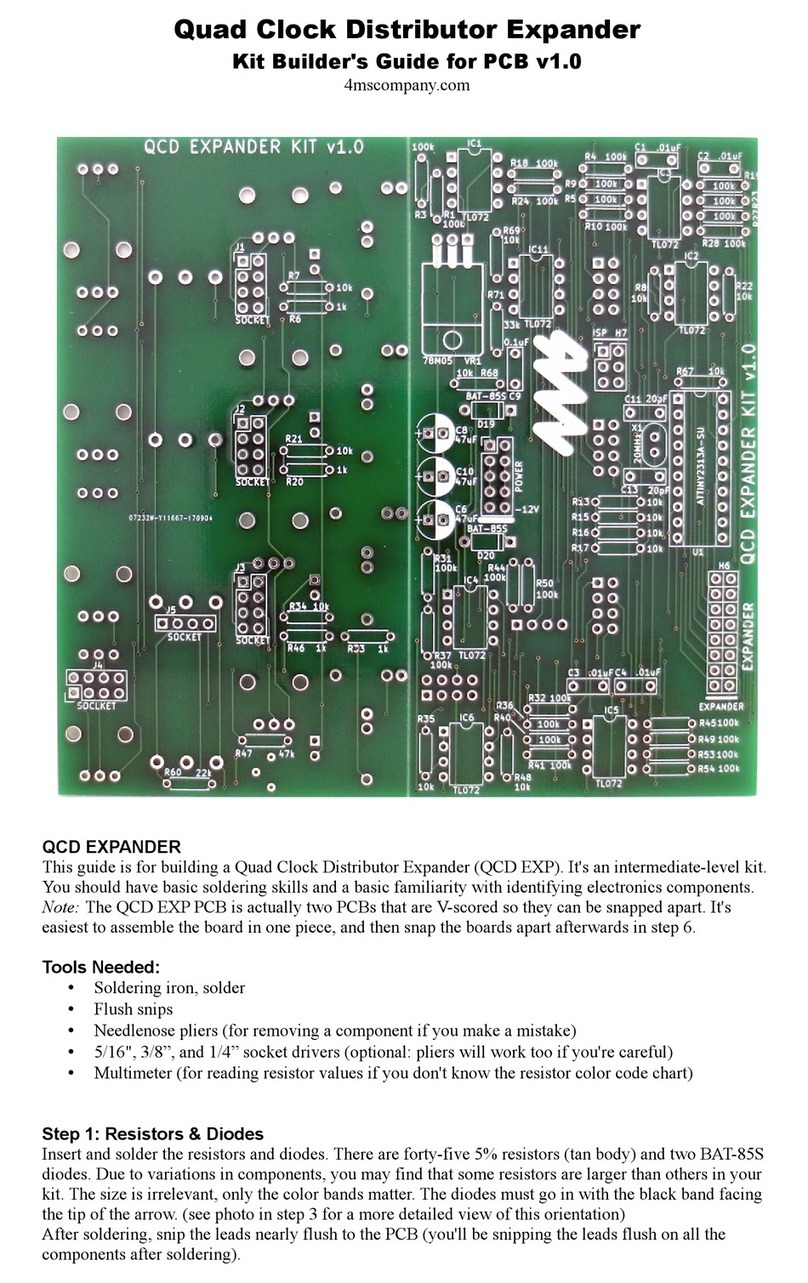
4ms
4ms Quad Clock Distributor Expander Builder's guide
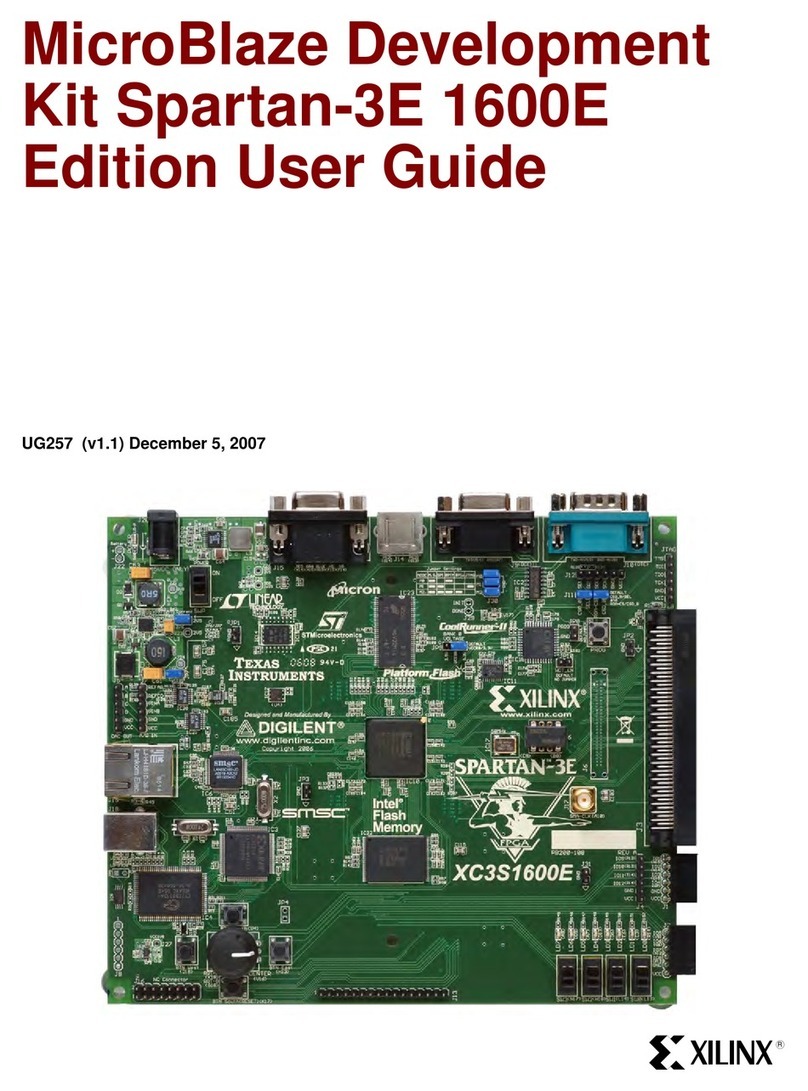
Xilinx
Xilinx MIcroBlaze Development Spartan-3E 1600E Kit user guide
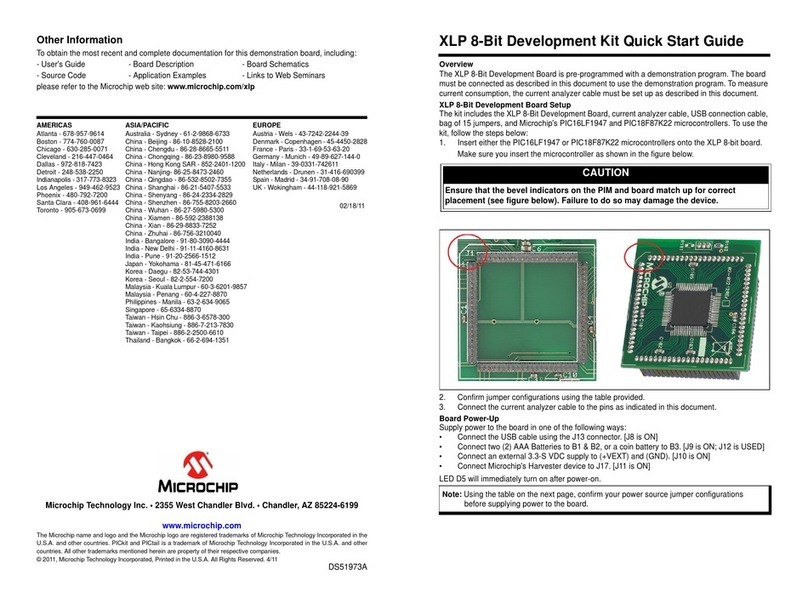
Microchip Technology
Microchip Technology XLP quick start guide
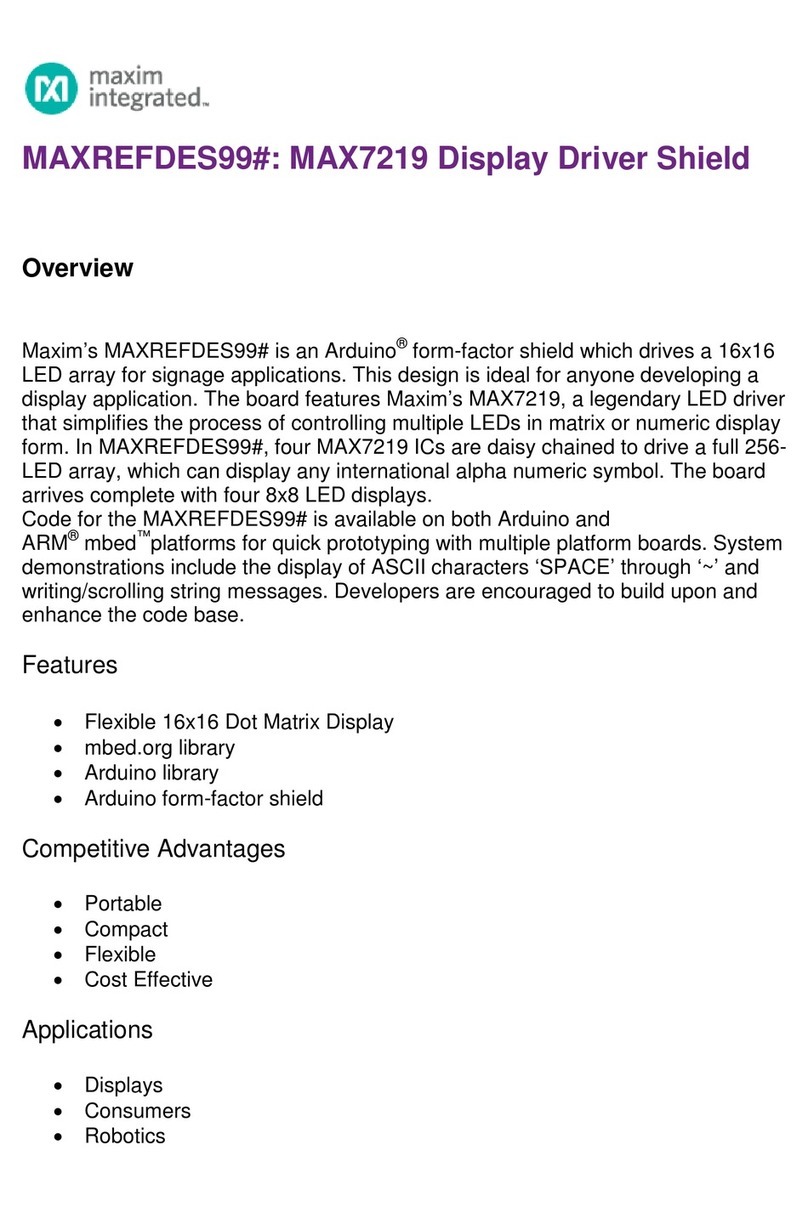
Maxim Integrated
Maxim Integrated MAXREFDES99 manual
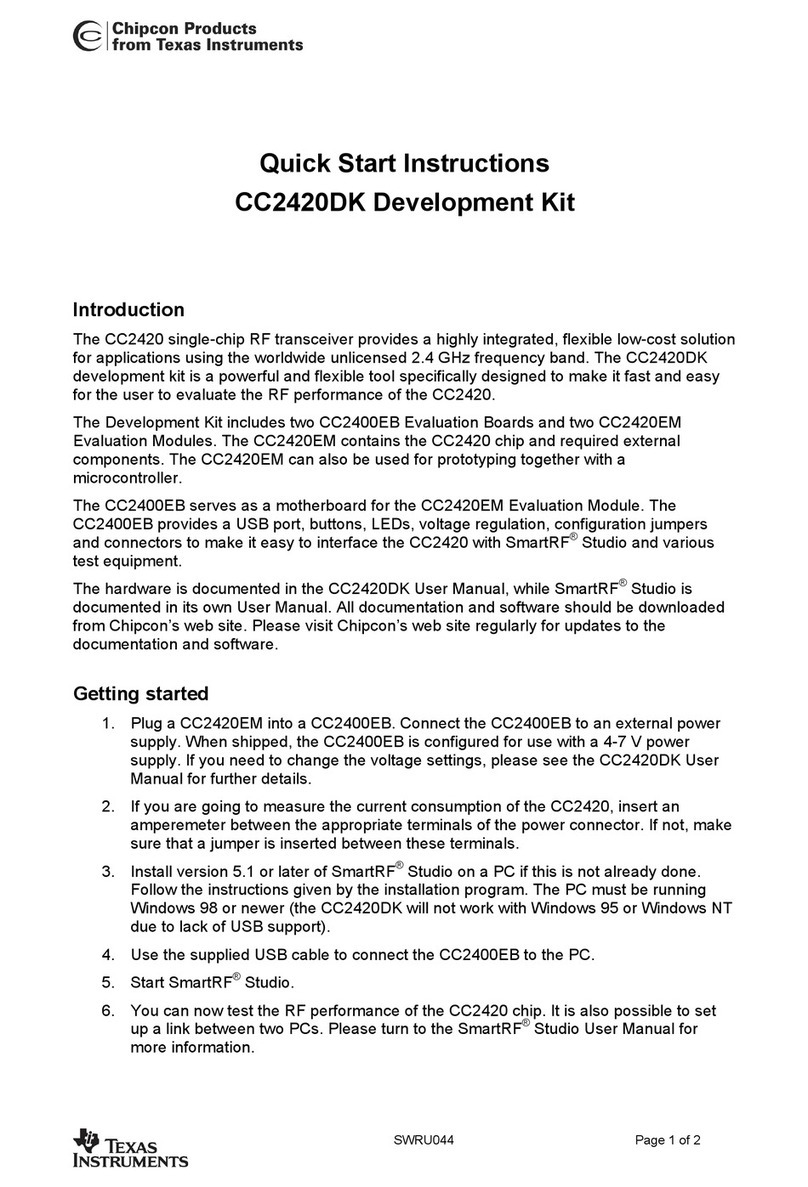
Texas Instruments
Texas Instruments Chipcon CC2420DK Quick start instructions
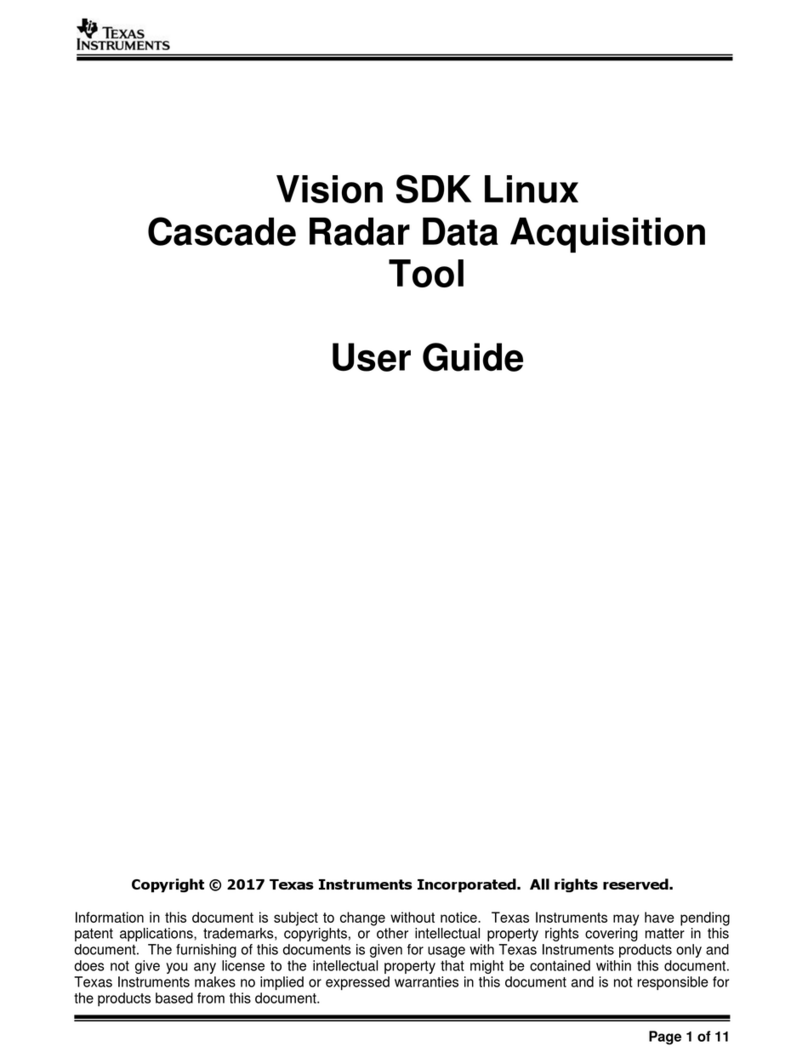
Texas Instruments
Texas Instruments Vision SDK Linux user guide
